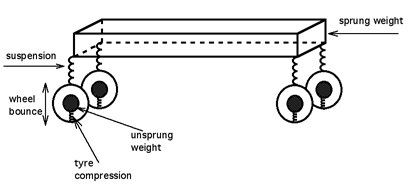 | ||
In a vehicle with a suspension, such as an automobile, motorcycle or a tank, sprung mass (or sprung weight) is the portion of the vehicle's total mass that is supported above the suspension, including in most applications approximately half of the weight of the suspension itself. The sprung weight typically includes the body, frame, the internal components, passengers, and cargo, but does not include the mass of the components suspended below the suspension components (including the wheels, wheel bearings, brake rotors, calipers, and/or Continuous tracks (Also called caterpillar tracks), if any), which are part of the vehicle's unsprung weight.
The larger the ratio of sprung weight to unsprung weight, the less the body and vehicle occupants are affected by bumps, dips, and other surface imperfections such as small bridges. However, a large sprung weight to unsprung weight ratio can also be deleterious to vehicle control.
